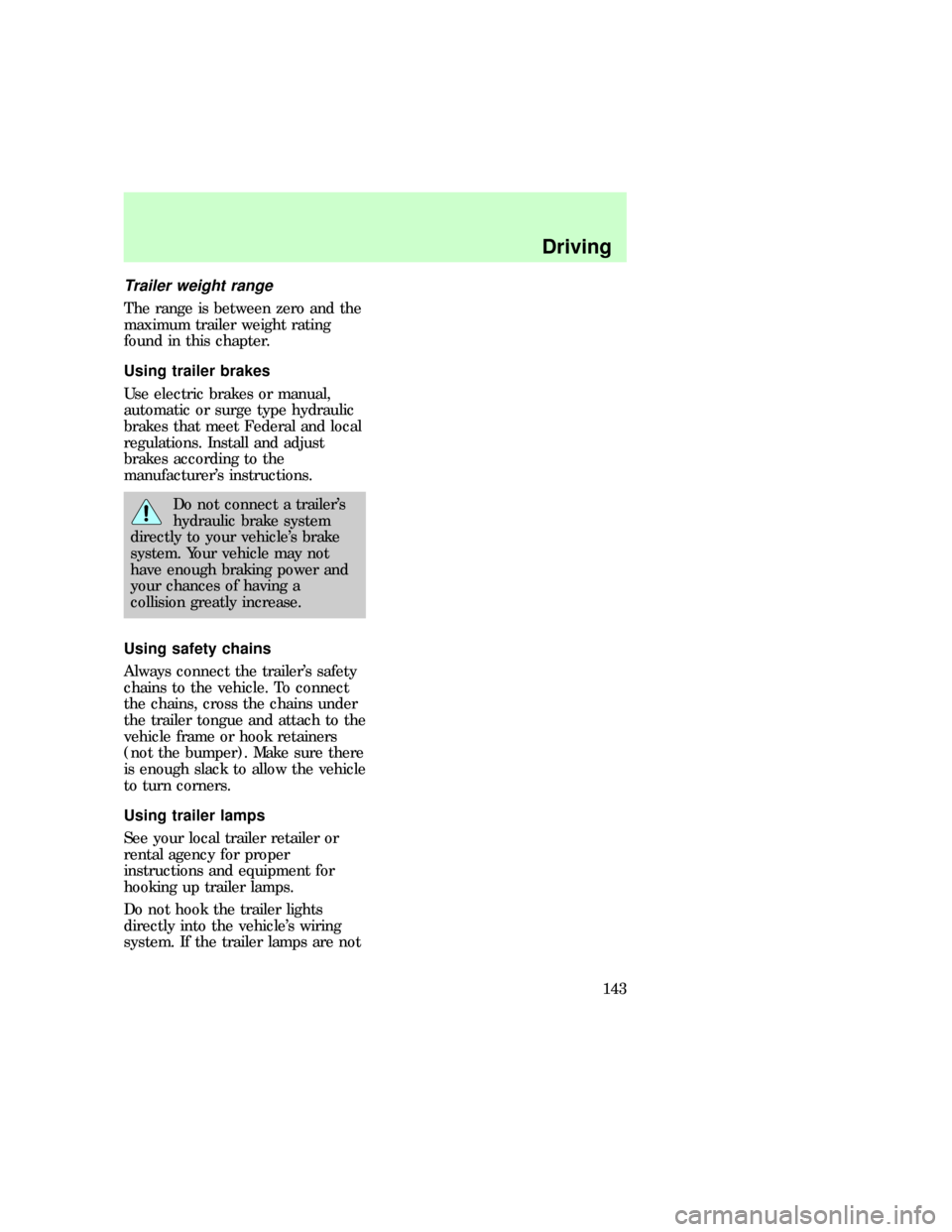Page 140 of 236
TRAILER TOWING TABLE 4X2 AUTOMATIC TRANSMISSION
GCWR (Gross Combined Weight Rating)/Trailer Weights
Engine
(EFI)Rear Axle
RatioMaximum
GCWR
Kg(Lb)Trailer Weight
Range Kg(Lb)
0-MaximumMaximum
Frontal Area of
Trailer Ft
2
2-DOOR
4.0 L3.27 3,175
(7,000)0-1,360
(0-3,000)50
4.0 L3.55 3,628
(8,000)0-1,814
(0-4,000)50
4.0 L3.73 4,082
(9,000)0-2,267
(0-5,000)50
4-DOOR
4.0 L 3.554,082
(9,000)0-2,177
(0-4800)50
4.0 L 3.734,535
(10,000)0-2,630
(0-5,800)50
4.0 L 4.104,535
(10,000)0-2,630
(0-5,800)50
5.0 L 3.734,990
(11,080)0-3,039
(0-6,700)50
TRAILER TOWING TABLE 4X4 AUTOMATIC TRANSMISSION
GCWR (Gross Combined Weight Rating)/Trailer Weights
2-DOOR
4.0 L3.27 3,175
(7,000)0-1,270
(0-2,800)50
4.0 L3.55 3,628
(8,000)0-1,723
(0-3,800)50
4.0 L3.73 4,082
(9,000)0-2,177
(0-4,800)50
4-DOOR
4.0 L 3.554,082
(9,000)0-2,086
(0-4,600)50
Driving
141
Page 141 of 236

TRAILER TOWING TABLE 4X4 AUTOMATIC TRANSMISSION
4.0 L 3.734,535
(10,000)0-2,540
(0-5,600)50
4.0 L 4.104,535
(10,000)0-2,540
(0-5,600)50
TRAILER TOWING TABLE AWD AUTOMATIC TRANSMISSION
GCWR (Gross Combined Weight Rating)/Trailer Weights
4-DOOR
5.0 L 3.734,990
(11,000)0-2,902
(0-6,400)50
NOTES:
- For high altitude operation, reduce GCW by 2% per 300 meters
(1,000 ft) elevation.
- For definition of terms and instructions on calculating your vehicle's
load, refer toLoading your vehiclein this chapter.
- Maximum trailer weights shown. The combined weight of the
completed towing vehicle and the loaded trailer must not exceed the
GCWR.
Calculating trailer loads
To determine the amount of weight
that your vehicle can carry:
²Obtain ratings from the Safety
Compliance Certification label
and the trailer towing
specifications in this chapter.
²Weigh your vehicle as you
customarily operate the vehicle
without cargo.
²Subtract the total weight of
passengers, driver and optional
equipment to determine the
total weight that your vehicle
can carry.
uno_calculating_towing
Driving
142
Page 142 of 236

Trailer weight range
The range is between zero and the
maximum trailer weight rating
found in this chapter.
Using trailer brakes
Use electric brakes or manual,
automatic or surge type hydraulic
brakes that meet Federal and local
regulations. Install and adjust
brakes according to the
manufacturer's instructions.
Do not connect a trailer's
hydraulic brake system
directly to your vehicle's brake
system. Your vehicle may not
have enough braking power and
your chances of having a
collision greatly increase.
Using safety chains
Always connect the trailer's safety
chains to the vehicle. To connect
the chains, cross the chains under
the trailer tongue and attach to the
vehicle frame or hook retainers
(not the bumper). Make sure there
is enough slack to allow the vehicle
to turn corners.
Using trailer lamps
See your local trailer retailer or
rental agency for proper
instructions and equipment for
hooking up trailer lamps.
Do not hook the trailer lights
directly into the vehicle's wiring
system. If the trailer lamps are not
uno_brakes_trailer
uno_safety_chains
uno_lamps_trailer
Driving
143
Page 143 of 236

working properly, the warning
lights in the instrument cluster
may not work properly.
Using a hitch
Do not use hitches that:
²clamp onto the vehicle bumper
²attach to the axle.
Distribute the load so that only 10
to 15% of the total weight of the
trailer is on the tongue. tie down
the load so that it does not shift
and change the weight on the
hitch. Follow the towing
instructions of a reputable rental
agency.
Driving while towing a trailer
Do not drive faster than 70 km/h
(45 mph) while towing a 454 kg
(1000 lb) trailer. Do not drive
faster than 72 km/h (45 mph) with
any weight trailer while towing in
hilly terrain or on hot days.
Speed control (if equipped) may
not work properly while towing on
long, steep grades.
If driving with an automatic
transmission:
²use D or L rather than while
towing up or down steep hills
²anticipate stops and brake
gradually.
Towing behind another vehicle
Do not tow your vehicle behind
another vehicle, such as an RV,
unless front wheel dollies are used.
uno_hitch
uno_driving_towing
uno_towing_behind
Driving
144
Page 144 of 236

Your vehicle can not be flat towed
with all wheels on the ground.
Servicing while towing
If you tow a trailer for long
distances, your vehicle requires
more frequent service than a
vehicle not used for towing. Refer
to the ªService Guideº for more
information on maintenance
intervals.
Using a step bumper
The rear bumper is equipped with
an integral hitch and requires only
a ball with a ô inch shank
diameter. The bumper has a Class
II capability (1590 kg / 3500 lb
trailer weight and 159 kg / 350 lb
tongue weight).
Use a frame mounted weight
distributing hitch for trailers over
1590 kg (3500 lb).
Launching or retrieving a boat
When backing down a ramp during
boat launching or retrieval,
²Do not allow the static water
level to rise above the bottom
edge of the rear bumper and
²Do not allow waves to break
higher than 15 cm (six inches)
above the bottom edge of the
rear bumper.
Exceeding these limits may allow
water to enter critical vehicle
components, adversely affecting
driveability, emissions and
reliability.uno_servicing_while_towing
uno_step_bumper_towing
com_launch-retrieving_boat.01
uno_roof-rack_title
Driving
145
Page 151 of 236
Number Fuse Amperage
RatingCircuits Protected
13 15 amp PCM system,
stoplamps, AWD,
anti-lock brake, speed
control, trailer tow
14 10 amp Anti-lock system
15 7.5 amp Air bag system,
instrument cluster
16 30 amp Wiper run relay
17 25 amp Cigar lighter
18 15 amp A/C system
19 25 amp Ignition coil, PCM
system
20 7.5 amp Radio, power antenna,
GEM system,
anti-theft, cellular
phone
21 15 amp Turn/hazard flasher
22 10 amp Turn signals
23 10 amp Rear wiper system
24 10 amp Starter relay
25 7.5 amp Speedometer, GEM
system
26 10 amp 5R55E/4R7OW
overdrive, DRL
system, backup lamps,
AWD, rear defroster
27 10 amp Under hood lamp, map
lamps, glove box lamp,
dome lamp, visor
lamps, accessory
delay, dimmer switch
illumination, 4x4
system
Roadside emergencies
152
Page 153 of 236
Maxi fuses
Fuse Amperage Circuits protected
1 30 Rear window defrost
2 30 PCM power relay
3 20 Fuel system, anti-theft
system
4 20 Headlamps
5 30 ABS system
6 30 ABS system
7 20 Trailer park LP and
trailer stop LP
8 30 Battery saver relay
and headlamp relay
9 50 Blower motor
10 30 Power locks, power
windows and power
seats
11 20 PCM memory and
horn
12 50 Air ride control relay
13 60 Instrument panel fuse
panel
14 60 Ignition
Mini fuses
1 30 JBL system
2 15 Rear wiper system
3 30 Power point
4 20 4WD system
5 15 Air suspension system
6 15 Alternator system
7 10 Air bag system
8 15 DRL/Fog
lamps/Off-road lamps
9 - Not used
Roadside emergencies
154
Page 159 of 236
tire and replace it with a full-size
tire as soon as possible.
It is not recommended that the
vehicle be operated in 4WD HIGH
or LOW modes with a temporary
spare. If 4WD HIGH or LOW
operation is necessary, do not
operate above speeds of 16 km/h
(10 mph) or for distances above 80
km (50 miles).
When driving with a temporary
spare,do not:
²exceed 80 km/h (50 mph) under
any circumstances.
²load your vehicle so that it
exceeds the maximum load
rating listed on the tire decal.
²tow a trailer.
²use tire chains on this tire.
²try to repair the temporary
spare or remove it from its
wheel.
²use the wheel for any other type
of vehicle.
²drive through an automatic car
wash.
JUMP STARTING YOUR
VEHICLE
The gases around the
battery can explode if
exposed to flames, sparks, or lit
cigarettes. An explosion could
result in injury or vehicle
damage.
com_jump-starting.01
Roadside emergencies
160